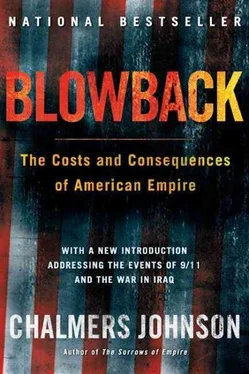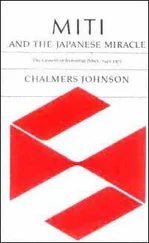Chalmers Johnson - Blowback, Second Edition - The Costs and Consequences of American Empire
Здесь есть возможность читать онлайн «Chalmers Johnson - Blowback, Second Edition - The Costs and Consequences of American Empire» весь текст электронной книги совершенно бесплатно (целиком полную версию без сокращений). В некоторых случаях можно слушать аудио, скачать через торрент в формате fb2 и присутствует краткое содержание. Год выпуска: 0101, ISBN: 0101, Издательство: Macmillan, Жанр: Старинная литература, на английском языке. Описание произведения, (предисловие) а так же отзывы посетителей доступны на портале библиотеки ЛибКат.
- Название:Blowback, Second Edition: The Costs and Consequences of American Empire
- Автор:
- Издательство:Macmillan
- Жанр:
- Год:0101
- ISBN:9780805075595
- Рейтинг книги:5 / 5. Голосов: 1
-
Избранное:Добавить в избранное
- Отзывы:
-
Ваша оценка:
- 100
- 1
- 2
- 3
- 4
- 5
Blowback, Second Edition: The Costs and Consequences of American Empire: краткое содержание, описание и аннотация
Предлагаем к чтению аннотацию, описание, краткое содержание или предисловие (зависит от того, что написал сам автор книги «Blowback, Second Edition: The Costs and Consequences of American Empire»). Если вы не нашли необходимую информацию о книге — напишите в комментариях, мы постараемся отыскать её.
Blowback, Second Edition: The Costs and Consequences of American Empire — читать онлайн бесплатно полную книгу (весь текст) целиком
Ниже представлен текст книги, разбитый по страницам. Система сохранения места последней прочитанной страницы, позволяет с удобством читать онлайн бесплатно книгу «Blowback, Second Edition: The Costs and Consequences of American Empire», без необходимости каждый раз заново искать на чём Вы остановились. Поставьте закладку, и сможете в любой момент перейти на страницу, на которой закончили чтение.
Интервал:
Закладка:
Talks to implement the Carter-Kim agreement opened on July 8, 1994, the day Kim Il-sung unexpectedly died, and as a result were immediately suspended. His death and the lack of credible information about his son and successor, Kim Jong-il, which might have set back the negotiations, actually seemed to have little effect on the discussions. But they did create serious problems in South Korea, where the government prohibited any public expressions of grief over Kim’s death and banned a church-sponsored human chain that was to extend to the Demilitarized Zone on the anniversary of Korea’s liberation from Japan. The South Korean government also released letters that Russian president Boris Yeltsin had given to President Kim Yong-sam on a visit to Moscow in June 1994 allegedly proving that Kim Il-sung had started the Korean War. The police even entered elite Seoul National University’s campus to arrest some 1,400 students who were calling for U.S. troops to get out of Korea and quit blocking unification.
On August 5, 1994, talks between North Korea and the United States resumed in Geneva, leading to an “Agreed Framework,” which the two sides signed that October 21. According to this agreement the United States was to arrange for the construction by the year 2003 of two 1,000-megawatt light-water reactors in North Korea to replace its current graphite-moderated reactors (a Soviet design from which plutonium can rather easily be extracted for possible use in nuclear weapons). The United States was also to provide fuel oil to replace energy lost by the closing of North Korea’s current reactors, and it was to guarantee that it would not use or threaten to use nuclear weapons on the Korean peninsula. Finally, the United States pledged to open trade and some form of diplomatic relations. For its part North Korea agreed to stop using and then dismantle its Russian reactors, ship its used nuclear fuel rods out of the country, remain a party to the Nuclear Non-Proliferation Treaty, and allow IAEA inspections of its nuclear sites.
The new reactors the United States was to provide were estimated to cost in the range of $4 billion to $4.5 billion. By March 1995, South Korea had agreed to pay about 70 percent of their cost and Japan 20 percent (with the remainder covered by various, mainly European countries). Although the United States negotiated the agreement, it agreed to pay nothing. All three nations—the United States, the Republic of Korea, and Japan—set up a new organization called the Korean Energy Development Organization (KEDO) to do the construction work.
The Japanese government supplied an initial $5.8 million so that KEDO could go into operation, but it has since regularly suspended funds whenever something has happened in North Korea that has not met its approval. In addition, elements in the U.S. government keep undercutting the agreement. U.S. Secretary of Defense William Cohen, for instance, said in Seoul in April 1997 that the United States intends to keep its forces stationed in Korea even if the two Koreas reunite. He gave no reason for this astonishing one-sided commitment, which implies an unending American imperial role in East Asia. He also predicted that North Korea was on the verge of collapse, which may explain why the United States has been so slow to implement the agreement. Instead of delivering fuel oil, as promised, or opening diplomatic and economic relations, as the North Koreans expected, the U.S. government has vacillated, often blaming Congress for its failure to fund the new relationship. Its impulse seemed to be to provide North Korea with just enough food to keep it from starving while hoping that its collapse would be “soft,” relatively nonviolent, and controllable. Unexpectedly, with the onset of the global economic crisis in 1997, South Korea itself came close to collapse and proved incapable of paying its share of the new North Korean reactors. The American government made no effort to find or raise replacement funds.
It is important to understand that the war scare of 1994, temporarily relieved by Jimmy Carter’s mediation and the subsequent Agreed Framework, sprang from two sets of related causes. The first was, of course, North Korea’s flirtation with nuclear brinkmanship in the context of the collapse of the Communist world that had sustained it since its creation. The second was a kind of military machismo on the part of the Pentagon and its assorted cronies and clients around the world. Without any regard at all for Korean and East Asian realities, the American military leadership and its political backers seemed intent on having another “splendid little war” in Korea, a rerun of the 1991 Gulf War, with all of its medals, promotions, and new post–Cold War assignments for the armed forces. Needless to say, the Pentagon strategists who abstractly think of Korea as a potential East Asian Iraq give no heed at all to Korea as a real place in time and space—it is not, for example, an uninhabited desert, and any use of force there will produce catastrophic casualties on all sides. Despite its being one of the most heavily armed places on earth, there is no plausible military “option” in Korea. The temporarily favorable resolution of the 1994 threat of nuclear proliferation in North Korea, once direct negotiations and diplomacy were given a chance to work, did not eliminate either of the contending forces that had caused it, and at the end of the 1990s they reerupted to produce a festering politicalmilitary sore.
Frustrated by the failure of the United States to deliver on what Pyongyang expected to get from the Agreed Framework, North Korea continued development of a medium-range and potentially an intercontinental-range missile force. The North had long worked on copying, improving, and manufacturing the Soviet-designed Scud short-range liquid-fueled battlefield missile, which it then exported to earn hard currency or barter wherever it could. Throughout the 1980s, it traded weaponry to Iran for oil, accounting for as much as 40 percent of all Iranian arms imports during the Iran-Iraq War. 8
After the Scud, the North’s next big project was to build an intermediate-range missile that conceivably might deter the massive forces the United States arrayed against it at bases in Japan and on the ships of the Seventh Fleet. It is not clear whether this effort was technologically serious or whether it merely aimed at deterrence by raising anxieties. The first North Korean IRBM (intermediate-range ballistic missile), the Nodong 1, was a Scud with additional engines bolted to its waist, giving it enough thrust to reach parts of Japan. The North only tested the Nodong once, in June 1993, when it went three hundred miles into the Sea of Japan. The accuracy of the Nodong and how many it has are unknown. Equally unknown is whether North Korea has even one nuclear warhead that it might attach to one of its missiles. The presumption is that the Agreed Framework interrupted its movement toward a nuclear device and that its missiles, even if they conceivably might arrive over their targets, are not armed with nuclear weapons.
However, in August 1998, a truly explosive development transformed this relatively benign environment into a paroxysm of Japanese and American overreaction and worst-case scenarios. On August 31, 1998, the United States government announced that North Korea had testfired a two-stage (later revised to a three-stage) liquid-fueled missile over Japan. The United States knew about the North Korean missile launch as it occurred; indeed one of the Air Force’s two RC-135S Cobra Ball surveillance aircraft, both assigned to the 55th Wing at Offutt AFB, Nebraska, was on station above the Korean peninsula to observe it. 9The Japanese, at least metaphorically, went ballistic. They condemned North Korea for a dangerous military provocation and an implied threat to Japan’s security. They cut off all contacts with the North and announced that they would launch their own spy satellites specifically to keep track of what was going on in North Korea and to end their dependence on military intelligence from the United States. They even professed to be thinking about withdrawing from the Agreed Framework.
Читать дальшеИнтервал:
Закладка:
Похожие книги на «Blowback, Second Edition: The Costs and Consequences of American Empire»
Представляем Вашему вниманию похожие книги на «Blowback, Second Edition: The Costs and Consequences of American Empire» списком для выбора. Мы отобрали схожую по названию и смыслу литературу в надежде предоставить читателям больше вариантов отыскать новые, интересные, ещё непрочитанные произведения.
Обсуждение, отзывы о книге «Blowback, Second Edition: The Costs and Consequences of American Empire» и просто собственные мнения читателей. Оставьте ваши комментарии, напишите, что Вы думаете о произведении, его смысле или главных героях. Укажите что конкретно понравилось, а что нет, и почему Вы так считаете.










